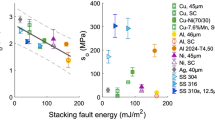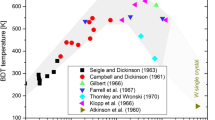Abstract
In light of the controversy that has existed between proponents of Peierls-Nabarro hardening and dispersed barrier hardening with regard to possible low temperature deformation mechanisms in bee and hep metals, this paper examines the effect of point obstacles on Peierls-Nabarro hardening. The statics of double kink nucleation over Peierls barrier on finite dislocation segments are studied in detail. Point obstacles such as interstitial impurity atoms are considered to limit the length of the dislocation segments. Adopting the rate theory approach, temperature dependence of the yield stress is then investigated as a function of the concentration of point obstacles. It is found that point obstacles have little or no effect on double kink nucleation processes, when the applied stress is near the Peierls stress or at low test temperatures. At lower applied stresses or at higher test temperatures, the present results are significantly different from predictions of the Dorn-Rajnak calculation. In the present theory, the applied stress on the dislocation, τ, is found to be finite and independent of test temperature in dilute solid solutions at elevated temperatures where the Dorn-Rajnak theory predicts vanishing τ. This apparent “athermal” component of τ increases linearly with the concentration of point obstacles, whereas temperature dependent part of τ decreases. These predictions are consistent with experimental observations on iron-base alloys.
Similar content being viewed by others
References
R. L. Fleischer and W. R. Hibbard:Relation between Structure and Strength in Metals and Alloys, p. 262, HMSO, London, 1963.
H. Conrad:Relation between Structure and Strength in Metals and Alloys, p. 476, HMSO, London, 1963.
P. Guyot and J. E. Dorn:Canad. J. Phys., 1967, vol. 45, p. 983.
J. E. Dorn:Dislocation Dynamics, p. 27, McGraw Hill Book Co., New York, 1968.
P. B. Hirsch: Proc. Int’l. Conf. on the Strength of Metals and Alloys, Suppl.Trans. Japan Inst. Metals, 1968, vol. 9, p. XXX.
R. L. Fleischer:Scripta Met., 1968, vol. 2, p. 113;Acta Met., 1967, vol. 15, p. 1513. R. J. Arsenault:Scripta Met., 1968, vol. 2, p. 99.
J. Dorn and S. Rajnak:Trans. TMS-AIME, 1964, vol. 230, p. 1052.
V. Celli, M. Kabler, T. Ninomiya, and R. Thomson:Phys. Rev., 1963, vol. 131, p. 58.
A. Seeger:Phil. Mag., 1956, vol. 1, p. 651.
W. Mason:J. Acoust. Soc. Am., 1955, vol. 27, p. 643.
R. J. Arsenault:Acta Met., 1966, vol. 14, p. 831.
J. Lothe and J. Hirth:Phys. Rev., 1959, vol. 115, p. 543.
A. Seeger and P. Schiller:Acta Met., 1962, vol. 10, p. 348.
A. Seeger and P. Schiller:Physical Acoustics, p. 361, IIIA, Academic Press, 1966.
H. Conrad and R. Jones: Int’l. Conf. on Titanium, London, May, 1968.
K. Ono:J. Appl. Phys., 1968, vol. 39, p. 1803.
K. Nakada and A. S. Keh:Acta Met., 1968, vol. 16, p. 903.
Author information
Authors and Affiliations
Rights and permissions
About this article
Cite this article
Ono, K., Sommer, A.W. Peierls-Nabarro hardening in the presence of point obstacles. Metall Trans 1, 877–884 (1970). https://doi.org/10.1007/BF02811768
Received:
Issue Date:
DOI: https://doi.org/10.1007/BF02811768




